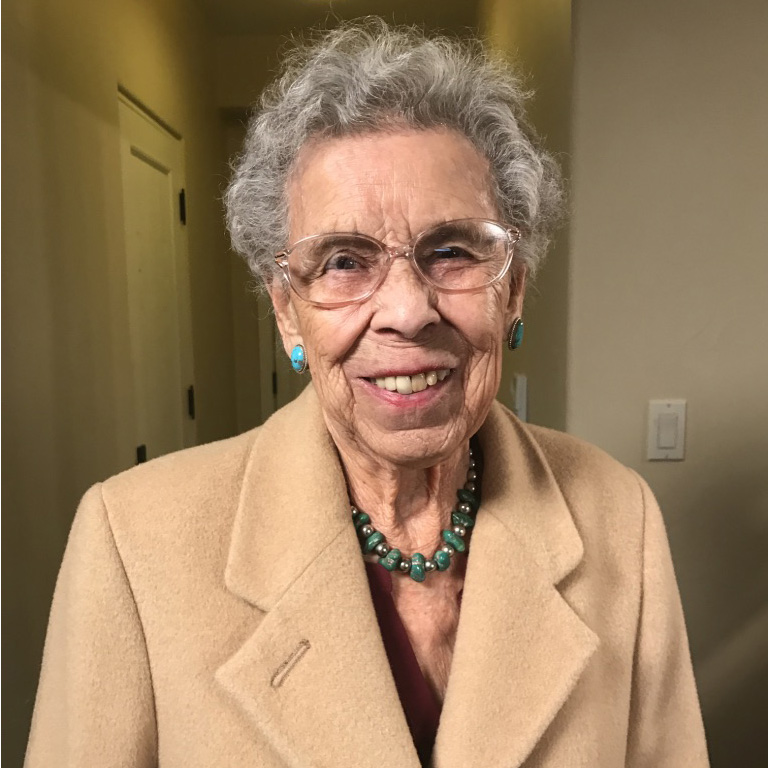We are sad to report the passing of our friend, biologist Floy Agnes Lee. Lee passed away at the age of 95 on March 6, 2018, in Santa Fe, New Mexico. Known by her friends as “Aggie,” she was the daughter of educators, who sparked her interest in science. Her father, a member of Santa Clara Pueblo, and her mother, a German-American, both taught and met at the now defunct Albuquerque Indian School.
In 1945, Lee graduated from the University of New Mexico with a Bachelor of Science in Biology. While studying there, she worked as a research assistant, and hoped to join the WASP (Women Airforce Service Pilots) after graduation. She learned to fly planes and felt that she was prepared to join the WASP. She stated in her interview with AHF, “I was accepted to learn the basics of flying so that I could go into the Women’s Air Force. The government did not provide for the flying, so I had to work in grocery stores to pay for flying lessons.”
In 1945, shortly after graduation, she arrived at Los Alamos to work as a hematology technician. She said, “Los Alamos wanted a biology student, or a graduate, to come and work in the hematology laboratory. I did not have a job lined up, so I said yes. That’s how I got to Los Alamos.” Lee was one of the few members of the Pueblos to work as a technician at Los Alamos. She remembered, “The chef was Santa Clara. I don’t know if at the time when I was there, that there were any other Indians working in the same capacity I was. I almost didn’t get hired at Los Alamos the second time [later in life], because I was a minority.”
Her job was to take blood samples from lab workers and to test the impact of radiation exposure on their blood cells. She tested blood samples from scientists Louis Slotin and Alvin Graves after the criticality accident that exposed Slotin to a fatal dose of radiation. Lee described her job: “My assignment was to collect the blood from the scientists, who were working on the atomic bomb. I had to learn how to take blood, how to read the blood cells, and all that’s connected with the hematology. I got along real well in that area. They sent me to go to different sites where the production was being done, and I would draw the blood from individuals.”
At Los Alamos, Lee often played tennis with Enrico Fermi. After the war, Fermi encouraged her to continue her education at the University of Chicago. She was reluctant at first, and commented, “I thought about it, and I said, ‘You know, my mother came from Indiana, and she ended up in New Mexico.’ I said, ‘If my mother was brave enough to leave Indiana and come that far, then I can go to Chicago.’”
Lee went on to work for Dr. Hermann Lisco and Dr. Joseph Allen at Argonne National Laboratory, “as a technician, just getting things prepared for them, for whatever they were doing.” After fourteen years, she earned her Ph.D. in Zoology. She explained, “I continued to work, and I decided that I went to Chicago to get my Ph.D., and I’m going to get it. I worked and went to school, and it took me about fourteen years to get the Ph.D. But I did it.”
From 1946 to 1979, Lee worked in radiation biology, conducting cancer research. During the 1960s, she used computer analysis to study chromosomes. She also worked at the Jet Propulsion Lab in California, before returning to Los Alamos, where she then worked as radiobiologist in the Lab’s Mammalian Biology Group. Lee was a member of many scientific associations, including the American Indian Science and Engineering Society, which she helped create.
Lee retired in New Mexico, and enjoyed golfing and painting in her free time. Her daughter commented that her mother advocated for science education and “really wanted young people to be able to learn it and look for opportunities to have careers in science.” She was featured in The Los Alamos History Museum’s recent exhibit, “Women, Science, and Project Y.”
For more on Floy Agnes Lee, please see our 2017 interview with her, or read her obituary in the Santa Fe New Mexican.





